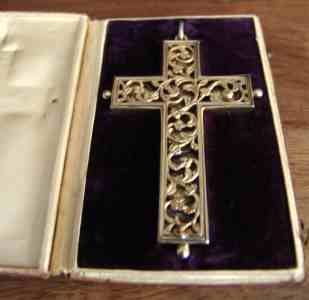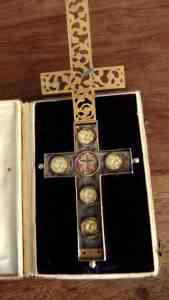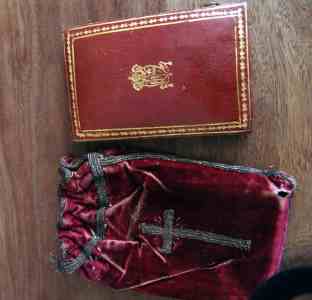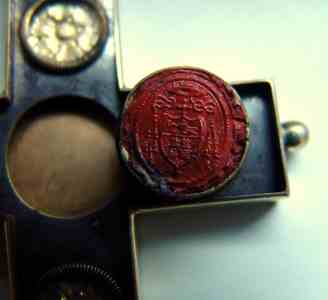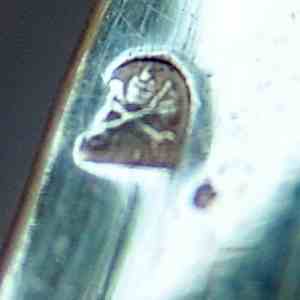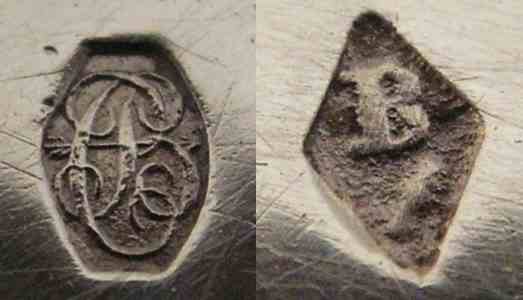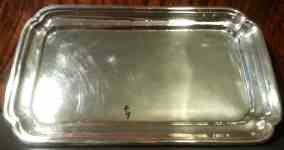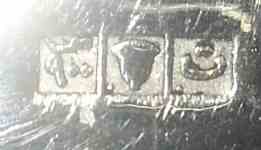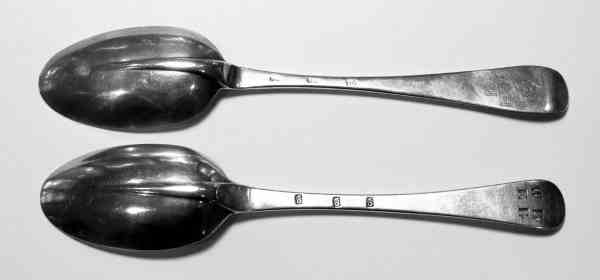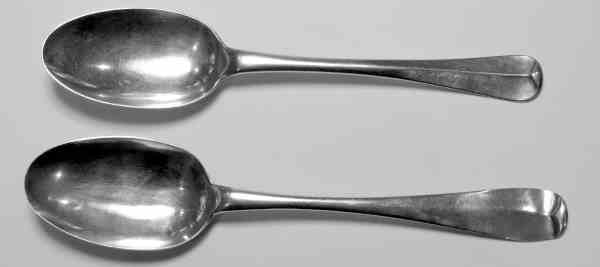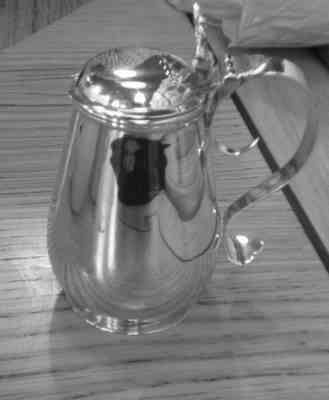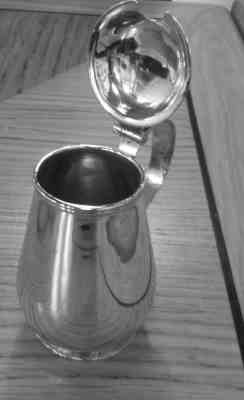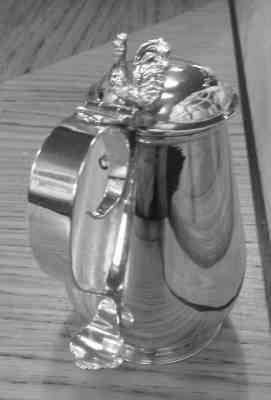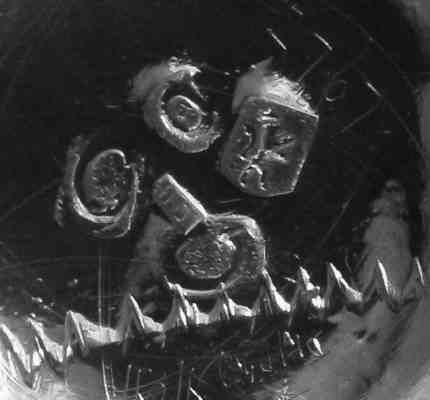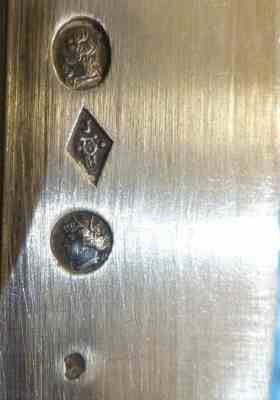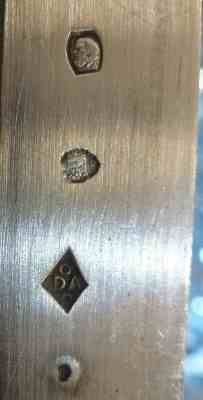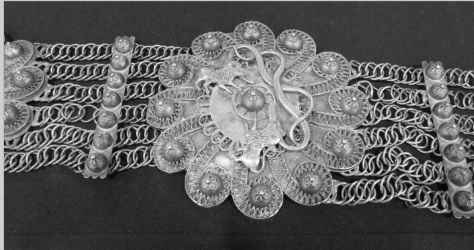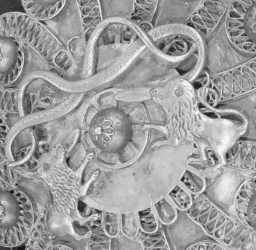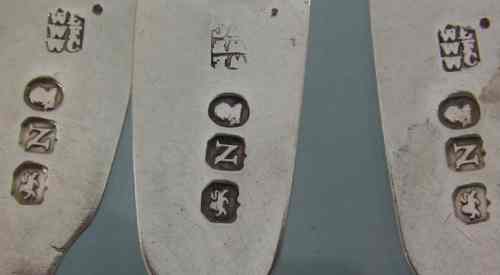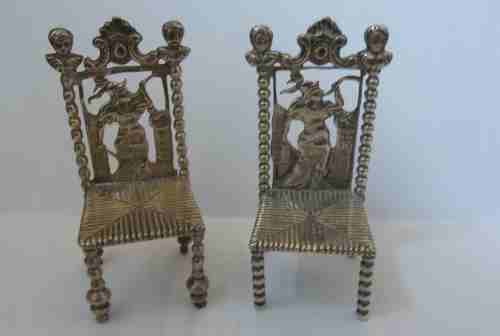
Bill Jackman presents:
Antique Silver Chairs in Miniature

Research has shown that silver miniature chairs, along with many
other silver miniatures items, were made in abundance in
Amsterdam (The Netherlands), from 1725-75.
The first dolls' house was introduced into Holland from Germany
in the 17th century and this accelerated the demand of silver
chairs to furnish these small masterpieces of craftsmanship.
The main customers were the wealthy ladies of Dutch families and
there was great rivalry to furnish their dolls' house with the
best silver furniture and equipment.
Large dolls' houses had 12 rooms and all of which required at
least one silver chair.
The production of silver toys in Amsterdam increased to satisfy
the request internal and from abroad. The export of silver
miniatures from the Netherlands continues today, though the
numbers of silversmiths have vastly decreased......
click
here

Welcome to new ASCAS members:
John W Gray - USA
Carolyn Law - USA
Ian Mactier - Australia
John Paynter - USA
Daniel Promach writes:
...I have this cross for many years and do not know if it is
original in the Vatican!
It has stamp on this side, and the capsule in the wooden cross
is also stamped!
I have some documents (letters 1845) that says that this cross
was donated by Pope Gregor XVI to Mr. Kolb, German Ambassador in
Vatican.
Could it be possible?
Hoping you can help me, thank you very much!
Your sincerely
Daniel Promach
Your item is a reliquary. The mark is the ancient mark of
Papal State (stato Pontificio). It was used, with many variants
until 1870. It's probably a gift of representation to the German
Ambassador.
See my website at
http://www.silvercollection.it/ROMEHALLMARKS.html and
http://www.silvercollection.it/dictionaryreliquary.html
Giorgio Busetto
Jolyon Warwick James writes
... I wonder if anyone can identify this mark? I know of three examples in Australia - which does not, of course, mean it is necessarily Australian.
It is a fiddle pattern table spoon bearing the initials "C"
Jolyon Warwick James
Jose Luis Muñoz writes
The silversmith is Gabriel Larriva, with factory in the
street de Armas, 21 from June 13, 1868. Secretary of the College
of silversmiths between 1868 and 1872. Trustee of silversmiths
in 1874.
The assayer is Merino Antonio Giménez, appointed assayer at the
death of Rafael Martos in 1881. He died in 1913
About the belt I can only add that it was manufactured in 1888.
Jose Luis Muñoz
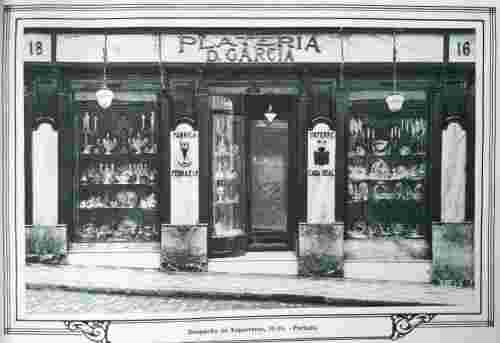
|
This month ASCAS presents an ancient image of the
shop/showroom:
PLATERIA D. GARCIA
Dionisio García Gómez was a renowned Madrid silversmith
in the first half of the 20th century. After his
apprenticeship to silversmith DH Adradas he opened his
own workshop in calle Fernán Nuñez. Soon after, he
became Royal Silversmith to the King Alfonso XIII and
moved to Ferraz 17, where the factory operated with a
hundred of workers. Continuing his success and expansion,
in 1920 he opened a store in calle de la Sal, 2 and 8,
and later in Esparteros, 16 and 18. Dionisio García
Gómez died in 1925, at the age of 37, leaving a thriving
business to his widow Doña Carmen Marquis and to his
sons Dionysius, Luis Rafael (Faluchi) and Fernando.
The management of the business was assumed by D. Antonio
Sánchez Fernández, the then chief of the staff and
personal friend of Dionisio.
The factory continued to expand its activity, opening
two more salerooms in Barcelona (calle de Fernando, 6
and calle Fontanella, 18). A new building was
constructed to host a larger factory in calle Juan de la
Hoz, 6 (with more than 200 employees) and another store
was opened in Madrid (Príncipe, 10).
The company, to support its workers, created a consumer
cooperative, a mutual aid society, an Academy of free
education and a library. Plateria D. Garcia can be
considered a family business since many family members
worked in the firm. By 1981 the company went bankrupt
having to close both the factory and the shops.
His best known mark is an amphora inside an oval and the
oldest pieces bear the inscription "D. García".
(information and images: courtesy Jose Luis Muñoz)
This image is part of the
FACTORIES, PLANTS, SALESROOMS, SHOPS AND WORKSHOPS: OLD
IMAGES section of www.silvercollection.it website
|
"A WORD per MONTH"
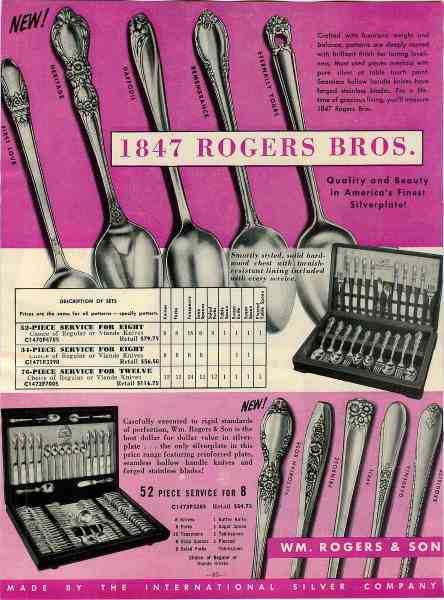
|
FLATWARE PATTERNS
1847 ROGERS BROS
Rogers is a recurrent name in American makers of
coin, sterling and silverplate ware. There is a great
confusion about the firms bearing this name. The number
of companies using the Rogers name is countless. The men
managing the various "Rogers" companies sometimes were
linked by family relationships but often this was not
the case. Lots of companies with this name were created,
merged, separated in an endless succession of
intertwined relationships. In 1862 Meriden Britannia
Company bought the hollowware division, tools and dies
of Rogers Brothers Mfg Co (incorporating Rogers, Smith &
Co). The production of the '1847 Rogers Bros' line
continued under the direction of William Rogers and in
1865 the plating shop was transferred from New Haven to
Meriden and merged with Meriden Britannia Co in 1866....
more
|
"A SILVERSMITH per MONTH"
|
|
ELEY FAMILY
WILLIAM ELEY I - WILLIAM ELEY II - CHARLES ELEY - HENRY ELEY
William Eley I was the son of
George Eley and was apprenticed to William Fearn in
1770. His first mark was registered in 1778 in
partnership with George Pierrepont (46 Little
Bartholomew Close).
Soon after William Eley I registered various marks alone
in 1778 (4 New Street, Cloth Fair and 2 George Street,
Martins-le-Grand), 1785, 1790 and 1795 (14 Clerkenwell
Green).
Marks in partnership with William Fearn were registered
in 1797 (14 Clerkenwell Green) and 1802 (1 Lovell's
Court, Paternoster Row).
In 1808 William Chawner entered in the partnership and a
new mark was entered with the initials of William Eley
I, William Fearn and William Chawner.
In 1814 William Chawner left the partnership and new
marks of William Eley I and William Fearn were entered
in 1814 and 1824.
William Eley I had three sons, William II, Charles and
Henry. All were apprenticed to their father and became
silversmiths.......
more
|
Closing our MAY 2015 edition of ASCAS Newsletter I hope you
have appreciated its content.
Your comments, suggestions and advice will be of great help.
My thanks to David Boddy, Pascal Drion, Dan Free, Christophe
Ginter, Bill Jackman, Derek Jones, Jose Luis Muñoz and Daniel
Promach, for their precious contributions.
Giorgio Busetto
Secretary
DISCLAIMER AND PRIVACY POLICY
ASCAS is a community of people having a common
interest in antique silver.
It is a non-profit association without commercial links.
Membership is open to whomever has a true interest in
this subject matter.
ASCAS has no real property and no fees are requested nor
accepted from members.
ASCAS keeps in touch with its members only through
periodical newsletters, e-mails and web-site updating
and ignores and is not responsible for any other
activity pursued by its members.
Likewise, ASCAS is not responsible for opinions,
evaluation and images displayed, and in any form
published or supplied for publication, by its members
who, in any case, maintain the property of their works
and assure the respect of national and international
legislation about Intellectual Property.
ASCAS does not have the full addresses of its members (only
town, country and e-mail address are requested for
membership).
ASCAS handles and protects with care its members' e-mail
addresses, will not disclose the addresses to third
parties, will use this information only to reply to
requests received from members and for communications
strictly related to its activity.
These rules are expressly accepted by submitting the
membership request.
|
|
 newsletter
# 132 May 2015
newsletter
# 132 May 2015








